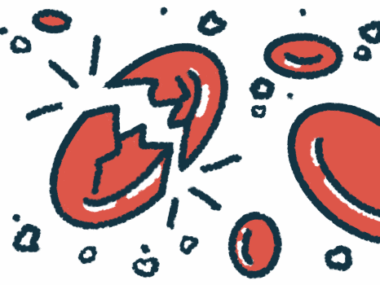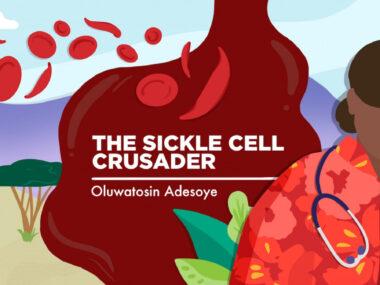Cardiomegaly and sickle cell complications of the heart
An enlarged heart is a potential comorbidity of sickle-shaped red blood cells
Written by |

Cardiomegaly, or having an enlarged heart, is a significant manifestation and a direct complication of sickle cell disease. It’s a common sign of cardiovascular issues and is more prevalent in adult patients.
Sickle cell disease itself is a chronic state of anemic that occurs as a result of frequent destruction, or hemolysis, of damaged, sickle-shaped red blood cells. This chronic anemia leads to hyperactivity of the heart.
To explain: Every organ needs oxygen to function properly, and red blood cells transport oxygen throughout the body. Sickle cell involves a deficiency of healthy red blood cells to carry that oxygen to tissues and organs. A mechanism is thus activated to compensate for this reduced oxygen-carrying capacity, making the heart work harder to meet the body’s metabolic demands. That harder work can eventually strain the heart, resulting in its enlargement and potentially leading to impaired cardiac function.
Additionally, sickle cell patients often have repeated blood transfusions, which can cause iron overload. When iron builds up in the heart, it can cause heart enlargement.
Cardiomegaly can also be a sign of other cardiovascular complications of sickle cell disease, like heart failure, cardiomyopathies, pulmonary hypertension, ischemic heart disease, and more. Other causes of cardiomegaly, though, might not be related to sickle cell disease. They include congenital heart disease, pericardial effusion, valvular heart disease, cardiac amyloidosis, thyroid disorders, pregnancy, and many more.
Cardiomegaly can be asymptomatic or symptomatic, with signs like difficulty breathing, chronic cough, leg swelling, abdominal swelling, chest pain, palpitations, easy fatiguability, and dyspnea on exertion, among others.
Regular screenings are important
Suppose you ‘re experiencing any of these symptoms as a sickle cell patient for an extended period. Kindly see your hematologist to carry out further medical investigations for appropriate diagnosis, management, and referrals to specialists. Patients with sickle cell disease should undergo regular screenings for cardiomegaly to monitor heart health and prevent complications.
During one of my hospital admissions in my early 30s, a chest X-ray revealed cardiomegaly. As a medical professional, I immediately understood the significance and implications of that diagnosis. I wasn’t surprised, as the finding validated the cardiovascular symptoms I’d been experiencing for a while.
I already knew I had cardiovascular complications, but I’d been reluctant to have a test done. The symptoms I’d been feeling included an inability to engage in even the easiest physical activities (exercise intolerance), which left me fatigued (easy fatiguability) and breathless (dyspnea).
Living with sickle cell disease for over 30 years, I’ve constantly had to survive with a low hemoglobin level of 8 g/dL or lower from childhood, and sometimes I’ve even needed a blood transfusion to survive. So it’s not surprising that my heart has had to do extra work to supply my organs and tissues, leading to its enlargement as a result of compensating for the effects of chronic anemia.
Cardiomegaly is commonly associated with, or is secondary to, hypertension. Still, it’s important to note, as I did above, that there can be other causes for this condition, and it’s possible to have cardiomegaly without being hypertensive. I vividly recall that during that three-week hospital stay, my blood pressure never exceeded 100/60 mmHg, which it’s always been, despite my having an enlarged heart.
In sickle cell patients, cardiomegaly can be a result of the disease itself rather than hypertension. Many sickle cell patients have approached me feeling confused after reading their chest X-ray reports stating “cardiomegaly secondary to hypertension.” They would tell me, “But I’m not hypertensive.”
An additional diagnosis like hypertension scares many sickle cell patients, which I understand. I had to deal with the fear of complications, too, before I overcame it. To reassure them, I explain the pathophysiology of cardiomegaly in sickle cell patients and emphasize that hypertension is not a prerequisite for an enlarged heart in this context. Above all, I reassured them that the radiological report could’ve been misleading because a comprehensive medical history wasn’t taken.
In conclusion, cardiomegaly in people living with sickle cell disease serves as more than just a complication; it can signal the potential for further issues such as arrhythmia and heart failure and also serve as an indicator of disease severity. That makes disease-modifying and preventive therapies like exchange blood transfusions and hydroxyurea, among others, become more important.
Early intervention plays a crucial role in managing health and preventing complications, slowing disease progression, or even reversing organ damage. Most importantly, it helps prolong lives, improve quality of life, and achieve optimal health outcomes.
Note: Sickle Cell Disease News is strictly a news and information website about the disease. It does not provide medical advice, diagnosis, or treatment. This content is not intended to be a substitute for professional medical advice, diagnosis, or treatment. Always seek the advice of your physician or other qualified health provider with any questions you may have regarding a medical condition. Never disregard professional medical advice or delay in seeking it because of something you have read on this website. The opinions expressed in this column are not those of Sickle Cell Disease News or its parent company, Bionews, and are intended to spark discussion about issues pertaining to sickle cell disease.







Fatima Jiddah Idris
Thank you doc for this write-up on cardiomegaly.. I was recently hospitalized for a sickle cell crisis (my physician made a diagnosis of acute chest syndrome) however chest x-ray revealed cardiomegaly 58% CTR and abdominopelvic scan showed slightly enlarged liver of 15.7cm. prior to the examination, I'd symptoms of easy fatiguability and I find it difficult to hold my breath these days. The Sonologist recommended ECG which I'm yet to do because my Dr assured it's not a big deal
Frankly speaking, I'm also not ready to deal with any complication right now.. I just recently had THR and I'm mentally exhausted. I greatly appreciate the effort you put in educating warriors, caregivers, and even the general public. XOXO 🥰
Damilola Kaffo
Thank you Doctor Oluwatoyin for your medical advice on Cardiomegaly and it's significant link to SCD. Honestly this is the first time knowing this and having a comprehensive explaination of this type of health condition.
Two weeks ago, I noticed some of the symptoms like easy fatigue, short breaths, palpitation in my chest, slight chest pain, cough, and a swolen left ankle and foot as mentioned in your article. The fatigue and short breaths was so serious that it took a miracle to get back home from work. Honestly, I didn't know how I made back home with all of this condition amidst the lock jam nature our road.
I went in for medical consultation and before seeing the Doctor I was asked to carry out TB, BSL and HIV test. Results came in later on that day after consultation and BSL was normal and others came out negative.
Doctor said while we wait for the results of those aforementioned tests she will like to look beyond TB. So she recommended a chest x-ray. She also prescribed some antibiotics.
Chest X-ray revealed that:
An area of patchy opacity is noted in the right lower lung zone, partially obscuring the right costophrenic sulcus.
No fluid level noted.
The rest of both lung fields are essentially clear.
Both pulmonary Hila are free.
The cardiac silhouette is enlarged with a CTR of 51%.
No significant mediastinal shift noted.
The diaphragm, recesses and bony thorax are within normal limits.
The surrounding soft tissue planes are preserved.
Conclusion: Pneumonic changes involving the right lung base? Infection.
CARDIOMEGALY. R/O Hypertensive heart disease.
I have gone back to see the Doctor that recommended the chest x-ray for results analysis, but she hasn't been duty. Then I made some personal research and you gave answers to my questions about the result.
Although another Doctor attended to me, prescribed Cefpodoxime Proxetil Capsules 200 mg and Vit. C 1000mg, but I still feel uncomfortable with the consultation. Please note it was in a General Hospital.
Thanks Dr.
Dunke Odion-Omojafoh
This is quite educative and informative. My 17 year ol son is a sickle cell warrior. With what I have read so far I am less scared now. Thank you so much.